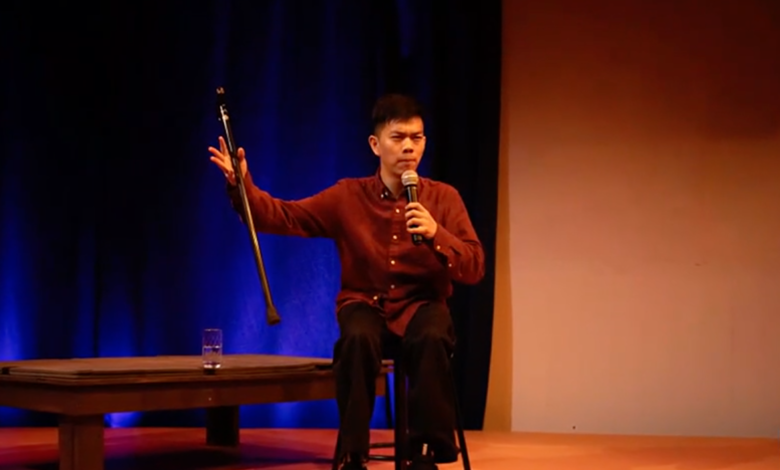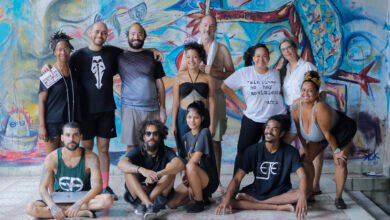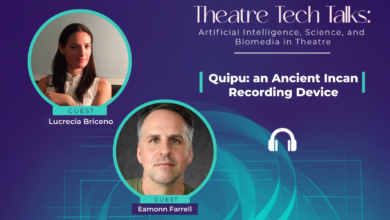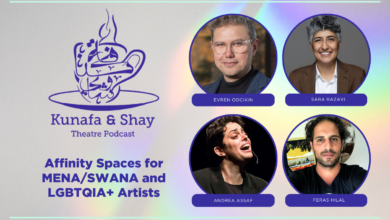Collaborating and Confronting the Able-Bodied Gaze in Herein Lies the Truth

Pang, a non-fiction writer and storyteller with no formal theatrical training who has toured with The Moth, approaches Herein Lies the Truth as an extended, physicalized essay rather than simply a piece of monologue. His collaboration with Kasimow, an assistant professor of Acting and Directing in the University of Iowa’s Department of Theatre Arts, began when the two were introduced by colleagues after Pang decided to create a performance for his MFA thesis for the University of Iowa’s Nonfiction Writing Program. When Pang expressed interest in enrolling in her beginning acting class, Kasimow thought formal acting training might not serve the needs of Pang’s project, leading the two to embark on a collaboration, working informally with an in-progress version of the text.
Audiences want…inspiration and therefore it suppresses the ability for disabled people to tell true, complex stories about themselves.
Herein Lies the Truth is built around a question often asked of Pang by strangers: “what happened?” Pang, who has an incomplete spinal cord injury, wears leg braces, and uses a cane, sought to tell a story around sex and disability that also skewered the able-bodied world’s insistence on his disclosure. “Everyone wants to know what happened,” says Pang. “I walk onto a stage [and] everyone’s expecting that story. You walk into public spaces, everyone leans in.” Pang’s text satirizes the vulnerability expected out of disabled stories by “play[ing] the trope of the lonely boy who is always fucking up and trying to find love” who eventually “overcomes disability in some metaphorical way” thanks to the power of love. Accessing the aesthetic space of “inspiration porn” gives Pang the opportunity to turn the piece to larger questions about the integrity of the three-act structure, the exclusion of disabled people in sexual spaces, and the question of what a “happy ending” looks like in an able-bodied culture.
To Pang, “audiences want…inspiration, and therefore it suppresses the ability for disabled people to tell true, complex stories about themselves.” As Pang revisits the story over two acts, he leaves the audience with the choice of two endings: “new definitions of pleasure” or “continued frustrations.” According to Pang, he is “trying to confront the audience with their feelings in the moment” by toying with the perception of what a “disabled story” is, telling “stories with no redemption” in place of the feel-good tale that is the typical result of this mode of storytelling. I had the distinct pleasure of being able to watch the audience of Herein Lies the Truth at a performance midway through the run. Having attended a tech run-through of the show, I was acutely aware of the show’s secrets, all of which serve a pointed analysis of able-bodied audiences’ expectations. As a result, the audience’s preconceived notions of a “disabled story” made themselves readily apparent. Beats of deep vulnerability and disclosure from Pang were met with archetypal noises of performed empathy, from soft “mm”s in support of his struggles to teeth-sucking sounds at the antipathy of the able-bodied world. Ironically (or perhaps not), the well-intentioned audience upholds the passively ableist behaviors that the show critiques, precisely as Pang has planned it.
Kasimow, who has a background in devising and physical theatre, sees the collaboration as any other. While deferring to Pang as the “lead artist” through the whole process, she worked to cultivate the “feeling in the audience of not knowing what is real” in Pang’s performance, a tendency central to her practice. “Whatever is true for Aaron’s body” on a given night is woven in with choreographed elements, creating a hybrid of staged and improvised movement. By collaborating with such a movement-oriented director, Pang can push past the traditional aesthetic underpinnings of solo performance. “I [don’t] want to just stand there, I want to be able to show my disabled body in movement,” Pang says, as featuring simple movement serves as a critique of “how, inevitably, people get uncomfortable with” disabled bodies.
Pang and Kasimow’s goal in crafting Herein Lies the Truth is to instill a sense of precarity that is itself satirical of the expectations of an audience watching a disabled body on stage. Referring to parts of the play where he stands unassisted or drops his cane, Pang mentions that “everything precarious is intentionally precarious.” Kasimow skillfully links this to the mime tradition (re-popularized by Jacques Lecoq) of the bouffon, the archetype of the outcast whose social bumbling underscores the constricting nature of society. Where Pang’s text requires its audience’s full attention, he and Kasimow amplify this sense of precarity as a means of eliciting sympathy for the “lonely boy” who is unable to meet the standards of polite—or able-bodied—society.





